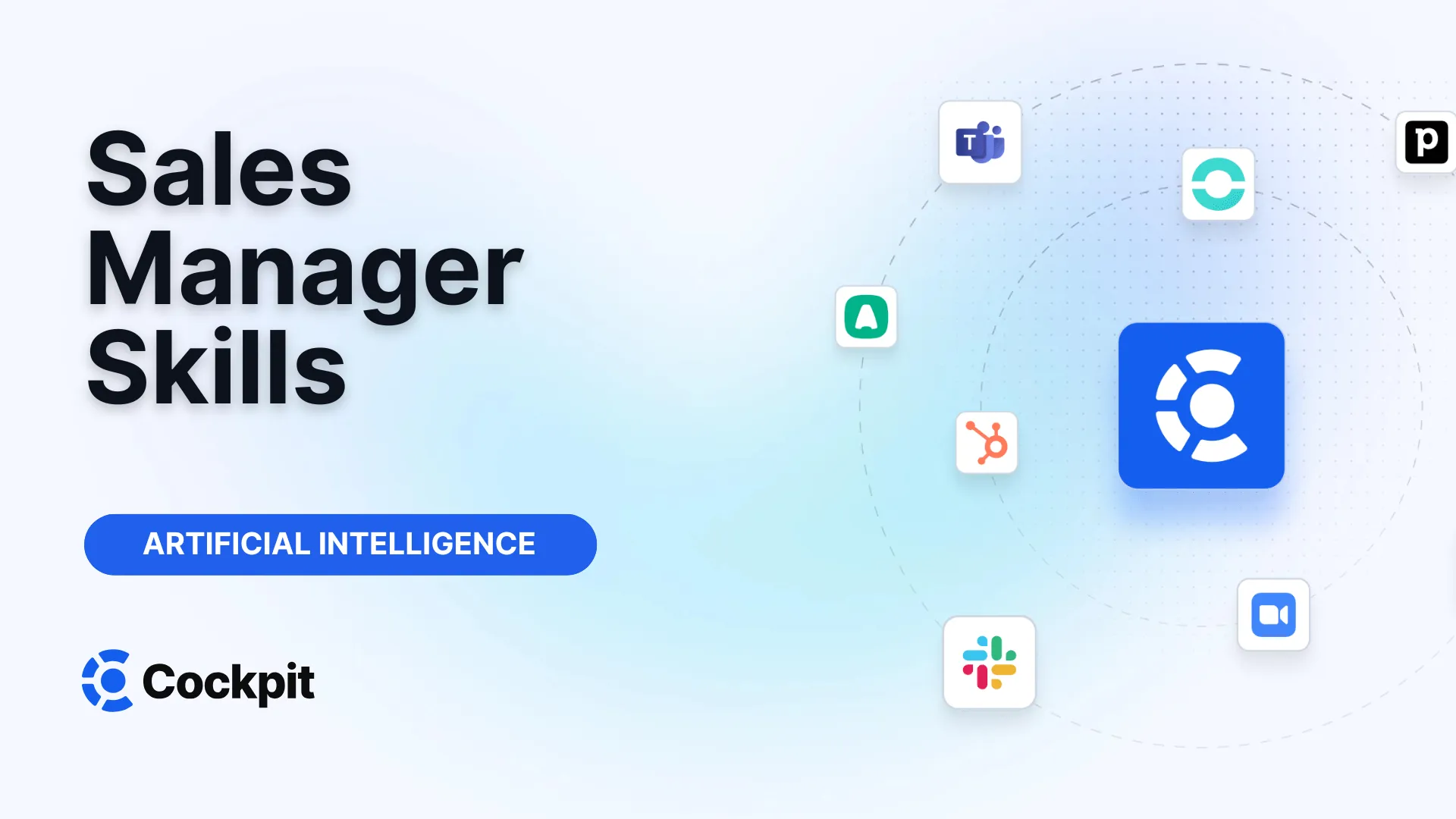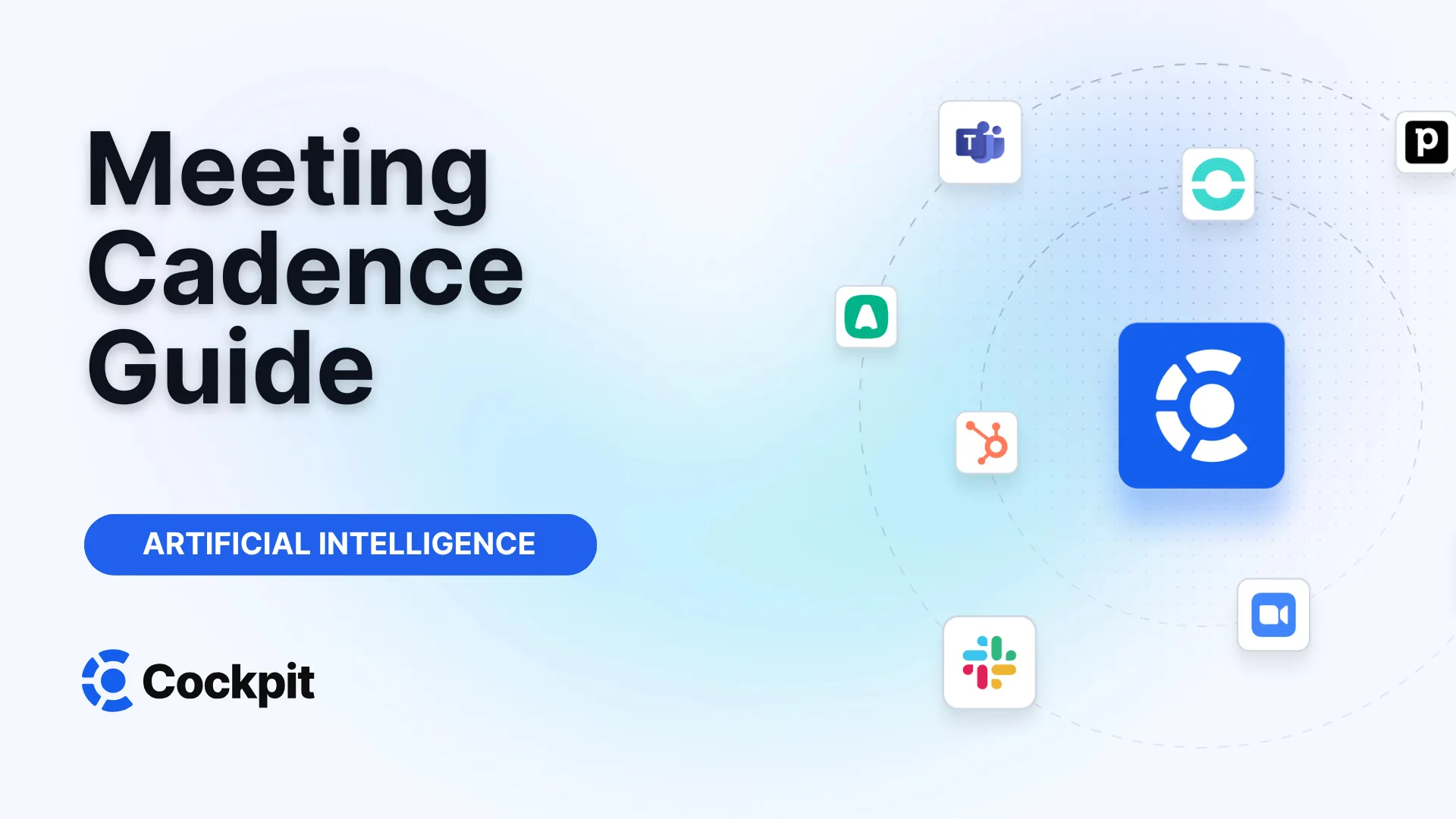Optimize your sales force in just a few clicks

Thousands of sales teams boost their performance with Cockpit. Why shouldn't you?
Explore CockpitSummary
Does your sales team reach its full potential? Do your representatives master every conversation, from prospecting to closing? If you notice a gap between the performance of your top performers and the rest of the team, the answer often lies in the quality and relevance of their training. Effective sales training is no longer a one-time event but a continuous journey that equips your sellers with the skills needed to navigate an ever-changing market. It is time to move beyond annual refreshers and explore the training topics that create true sales champions.
How can you transform promising sellers into consistent top performers? By choosing the right development areas and adopting a culture of continuous improvement. The key to success lies in a comprehensive, relevant, and evolving training program that addresses current challenges and prepares for tomorrow's opportunities.
Why Traditional Sales Training Is No Longer Enough
For years, sales training has been synonymous with intensive seminars at the annual kickoff or catch-up sessions for newcomers and underperformers. Although well-intentioned, this approach is often insufficient. The sales world evolves at a rapid pace: buyer expectations change, new competitors emerge, and technologies redefine interaction methods. One-time training quickly becomes obsolete, leaving teams ill-prepared for real-world challenges.
Numbers confirm this. A RAIN Group study revealed a significant gap in perception of training effectiveness: 71% of the highest-performing sellers consider their training "extremely or very effective," compared to only 45% for other sellers. Even more striking, the average closing rate on sales proposals is 11 points higher for teams benefiting from highly effective training. This gap is not trivial; it represents millions of potential revenue lost or gained.
To bridge this gap, organizations must shift from an event mindset to a culture of continuous learning. This means covering a broad range of sales training topics, not only during onboarding but throughout the seller’s career. It involves building solid skills and continuously reinforcing them so every team member is ready to face any sales scenario at any time.
Fundamental Sales Training Topics
Before diving into advanced techniques, it is crucial to ensure that every team member masters the pillars of sales. These fundamental skills form the foundation on which sustainable performance is built. They cover the entire sales cycle, from first contact to pipeline management.
Mastering the Heart of Consultative Selling
Modern selling is primarily consultative. The buyer is not seeking a mere supplier but a trusted partner capable of understanding their challenges and helping them achieve their goals.
1. Building rapport and trust: Trust is the foundation of any long-term B2B sales relationship. A Forrester study highlights that trust is the most important factor determining whether a company will choose to work with you. Training must therefore go beyond sales techniques to teach the principles of rapport:
- Empathy: The ability to sincerely understand the interlocutor’s feelings and challenges.
- Authenticity: Being oneself and transparent to create a genuine connection.
- Similarity: Finding common points to strengthen the bond.
- Shared experience: Creating a history of collaboration and mutual success.
2. Conducting a thorough needs discovery: This is perhaps the most critical yet often neglected skill. Nearly 60% of B2B buyers feel most sellers do not take the time to understand their needs and goals. A seller presenting a solution without fully grasping the problem is doomed to fail. Training must teach questioning techniques such as the "five whys" method to get to the root cause of a problem rather than stopping at symptoms.
3. Qualifying prospects and opportunities: Time is the most precious resource for a seller. Spending it on prospects who do not fit your ideal customer profile (ICP) or have no real buying intent is a waste. Training should equip sellers with robust qualification frameworks.
The FAINT qualification model
An effective approach to qualifying opportunities is ensuring the following conditions are met:
- Funds: Does the prospect have the financial capacity to buy, even if a formal budget has not yet been allocated?
- Authority: Are you speaking with the decision-makers?
- Interest: Have you sparked genuine interest in the value your solution can provide?
- Need: Have you identified specific and urgent needs your offering can solve?
- Timing: Is there a clear timeline for decision-making and implementation?
When an opportunity checks all these boxes, it deserves your team’s full attention.
From Planning to Presentation: Executing the Sale
Once the foundations of relationship and understanding are established, execution becomes paramount. Each step must be conducted with professionalism and strategy.
4. Pipeline management and prospecting: A healthy pipeline drives every sales team. Sellers must know how to build it, prioritize leads based on quality and urgency, and measure their results. Prospecting, which takes about 17% of a seller’s time, is a key skill. Top performers dedicate even more time, performing thorough research before each outreach. Training should include role-playing scenarios for cold calls and email writing, essential channels to fill the top of the funnel.
5. Call planning: An unprepared call is a missed opportunity. An Oracle study revealed that 11% of prospects ignore sellers because they are insufficiently prepared. Training must supply concrete tools like pre-call checklists for each stage of the sales cycle (discovery, demo, closing). A well-prepared seller inspires confidence and demonstrates professionalism.
6. Presenting the value of your products: It is not about reciting a feature list but demonstrating how your product solves the client’s problems and delivers tangible value (time savings, cost reductions, risk mitigation). Sellers must become value experts and adapt their presentation to the context and specific needs of each prospect. Dedicated training sessions led by product teams during new feature launches are essential to maintain this level of expertise.
Expert Tip
For product training, do not simply present features. Organize workshops where sellers themselves use the product to solve a fictitious customer problem. This hands-on approach anchors knowledge much better and develops their ability to articulate value concretely.
Advanced Sales Training Topics to Excel
Once fundamentals are mastered, it is time to develop the skills that distinguish very good sellers from true elites. These advanced topics enable handling more complex situations, influencing decisions, and building strategic long-term relationships.
Handling Objections and Complex Negotiations
No sales journey is a smooth sail. Objections and negotiations are unavoidable steps that, if well managed, strengthen the seller’s position.
7. Objection handling: A Mindtickle study found that 54% of sales calls contain more negative sentiments (uncertainty, objections, competitor mentions) than positive ones. A “no” or hesitation is not the end but an invitation to go deeper. Training must teach sellers not to fear objections but to welcome them as opportunities to clarify and reassure. It is helpful to categorize common objections:
- Need: “I'm not sure we have this problem.”
- Urgency: “This is not our priority right now.”
- Trust: “How can I be sure your solution will work for us?”
- Money: “It’s too expensive/out of budget.”
For each category, sellers should practice a four-step process: listen, understand, respond, and confirm.
8. Mastering negotiation: Many sellers enter negotiations from a position of weakness, prepared to concede on price to close the deal. The best negotiators are 12.5 times more likely to be satisfied with their results. One powerful concept to teach is the BATNA (Best Alternative to a Negotiated Agreement). It is the best option a seller has if an agreement cannot be reached. Knowing your BATNA and being ready to walk away grants tremendous control and confidence.
9. Countering buyer tactics: Professional buyers often use tactics to unsettle sellers. Training should help recognize and counter these maneuvers.
| Buyer Tactic | Description | How to Respond |
|---|---|---|
| "Good Cop, Bad Cop" | A friendly buyer is replaced by a tougher decision-maker (the “bad cop”) who challenges everything at the last minute. | Stay calm, reaffirm the agreed value, and resist pressure. Remind them of agreements made with the “good cop.” |
| Red Herring | The buyer focuses on a minor point, obtains a concession there, then demands a major concession on an important issue. | Identify non-critical points. Do not concede on major points in exchange for concessions on insignificant details. |
| "Sharpen Your Pencil" | A vague request like “You need to do better” pushes the seller to lower the price without justification. | Ask for clarifications. “To understand better, on which specific aspects of the proposal do you think we can improve?” |
| "Just One Last Thing..." | Right before signing, the buyer asks for an additional small concession, exploiting the seller’s eagerness to close. | Politely explain that the deal was finalized based on discussed terms and any additions would require reevaluating everything. |
Developing a Strategic Advantage
Beyond individual transactions, the best sellers think strategically to maximize long-term value.
10. Competitor knowledge: Your prospects evaluate your competitors. Not knowing their strengths and weaknesses is a professional mistake. 57% of sales directors feel competition has intensified. Training must include creating and updating battle cards: concise sheets comparing your offer to main competitors, highlighting your key differentiators.
11. Key Account Management: Acquiring a new client costs more than selling to an existing one. Yet many companies lack formal processes to develop their most important accounts. A five-step process can be taught: Strategy, Research, Action Plan, Execution, and Review. Top sellers are 80% more likely to have mature strategic account management processes.
12. Selling through storytelling: Facts appeal to reason, but stories appeal to emotions and drive action. A good sales story follows a convincing structure positioning the buyer as the hero of their own transformation story. The Convincing Story Framework from RAIN Group is an excellent model to teach:
- Change is inevitable: Demonstrate understanding of the buyer’s world and the forces driving change.
- Success vs. failure: Highlight stakes. What are the benefits of change and the consequences of inaction?
- The enticing opportunity: Paint a vivid picture of the new reality your solution enables. Quantify impact (ROI).
- The breakthrough: Explain how your unique approach enables transition from the current state to the new reality.
- It will work: Reassure the buyer, not only about the solution but your ability to be the right partner to achieve it.
Modernizing Your Approach: Methodologies and Tools
Choosing the right topics is one thing; teaching them effectively is another. Modern methodologies and today’s technologies enable creating more engaging, measurable, and continuous learning experiences.
Effective Training Methodologies
The era of top-down lectures is over. For lasting learning, approaches must be varied and interactive:
- Role-playing: Essential to practice objection handling, cold calling, or negotiations in a risk-free environment.
- Virtual simulations: Interactive scenarios where sellers make decisions and immediately see the consequences.
- Peer learning: Encourage sellers to share successes and failures. Creating “best call” libraries is an excellent way to spread best practices.
- Microlearning: Offer short, targeted content (5-minute videos, quick quizzes) to reinforce knowledge regularly without disrupting daily work.
Leveraging Technology for Continuous Improvement
Technology, particularly conversational intelligence, has revolutionized sales training. It enables moving from coaching based on subjective impressions to coaching grounded in objective data.
Platforms like ours transform every sales call into a learning opportunity. By recording, transcribing, and automatically analyzing each conversation, we provide managers and sellers with insights previously inaccessible. This creates a virtuous feedback loop and personalizes training at scale.
Our AI Playbook feature goes far beyond simple summaries. It objectively evaluates every call against your sales methodology.
- Did the seller ask proper discovery questions?
- Did they appropriately present the value proposition?
- Did they identify and handle objections according to best practices?
Managers can instantly spot gaps and tailor their coaching precisely. Additionally, by enabling creation of clips and playlists of best moments (perfect objection handling, exemplary call closing), we facilitate spreading standards of excellence across the team, accelerating onboarding and overall improvement.
Note
One of the biggest benefits of AI analysis tools is freeing sellers from manual note-taking. Knowing each detail is captured and synced automatically with the CRM lets the representative focus 100% on active listening and relationship building—two fundamental skills often sacrificed for data entry.
Measuring the Return on Investment of Your Training
Training is a profitable investment only if its impact is measurable. Defining the right Key Performance Indicators (KPIs) is essential to evaluating the effectiveness of your programs and continuously adjusting them.
Key Metrics to Monitor
Beyond participant satisfaction, track the evolution of concrete commercial metrics before and after training sessions:
- Win rate: The percentage of opportunities won relative to opportunities engaged.
- Sales cycle length: Effective training should reduce the time needed to close a deal.
- Average contract size: Better-trained sellers in cross-selling and upselling should increase contract value.
- Quota attainment rate: The ultimate indicator of individual and collective performance.
- Pipeline conversion rate: Improved qualification skills should raise the percentage of leads turning into real opportunities.
Ensuring Your Training Pays Off
Training day is just the beginning. Forgetting is the number one enemy of learning. To ensure durable skill retention, reinforcement strategies must be implemented:
- Spaced repetition: Briefly revisiting key concepts at regular intervals (via quizzes, email reminders) significantly improves information retention.
- Managerial coaching: First-line managers are the best coaches. They must be trained to debrief calls, provide constructive feedback, and reinforce training concepts.
- Creating a learning culture: Celebrate efforts and progress, not just results. Encourage curiosity and calculated risk-taking.
Sales training is not an expense but a strategic investment in your most valuable asset: your human capital. By selecting the right topics, adopting modern methodologies, and leveraging intelligent technologies to measure and reinforce learning, you are not merely training your sellers. You are building a resilient, adaptable sales machine ready to dominate its market for years to come.
How to Tailor Sales Training to the Specific Needs of Our Team?
Personalization is key to effective training. The first step is conducting a skills gap analysis. Use conversational intelligence tools like Cockpit to analyze actual calls and objectively identify the team’s strengths and weaknesses (e.g., recurring difficulties in the discovery phase or handling price objections). Then, segment your training: the needs of a Business Development Representative (BDR) focused on prospecting differ from those of an Account Executive (AE) who manages complex sales cycles. Finally, regularly gather feedback from your teams to adjust programs. A data-driven and human-centered approach will ensure every training euro invested generates maximum return.




